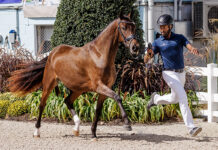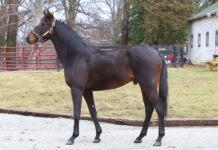I’m always reading about judges making proclamations from the bench. They attempt to educate the public or sway popular sentiment through their rulings. I’m never going to wear a black robe or wield a gavel, but I have been judging horse shows for fifteen years now, and recently it seems like I’ve been judging almost every weekend. That’s about to wind down, thankfully, because I purposely scheduled all of my judging assignments in the spring and early summer to avoid the heat. But with my last few judging jobs I made note of a few topics that I’d like to cover in my blog. Keep in mind that these are only my personal opinions. Yet if I’m the one holding the clipboard at the horse show, it’s the only one that really matters.
- Why would someone enter a horse show without having a basic understanding of the rules for competition? Some of the shows I judge cater to entry-level exhibitors. I come prepared to spend time explaining rules concerning appropriate tack and equipment. But most of the shows I judge are sanctioned by county or regional associations. They’re stepping stones to nationally rated shows. At that level, I expect exhibitors to know that a hunter can’t wear a crocheted ear bonnet, that huntseat equitation riders are not allowed to wear “pizza cutter” roweled spurs, that flash nosebands are against the rules and that if a crop is carried in a jumper class, it cannot exceed 30” in length, regardless of how bad a stopper the horse might be.
- Please don’t ride your lame horse in a show. Case in point: Two weekends ago a teenager rode her pretty bay gelding a hunter under saddle class. When I had the class reverse to track the second direction, it was obvious that her horse was lame in the right hind leg. I didn’t place the horse (because soundness is one of the criteria), and as she rode by my booth I leaned out and said, “I really like your horse. But he seems quite off on his right hind. You need to take a look at him.” She acknowledged that she heard me. I saw her slide off her horse and chat with her trainer. But when the over fences classes resumed, she came right back in on the very same sore horse. She tried to camouflage the horse’s unsoundness by proceeding straight into the canter on her opening circle. This necessitated a call from me over the walkie-talkie to the horse show manager. I realize that exhibitors have their heart set on competing. But aren’t we supposed to keep the horse’s welfare foremost in our minds.
- Some female adult amateur hunter riders expend an extraordinary amount of energy and money on their turnout. They wear the latest fashions in hunt clothes, their boots feature customized options (including punched toe caps and discreet zippers), and their horse is decked out in every item that can possibly be lined in sheepskin. Oh. And they’re also riding in the most expensive saddle they can afford, complete with whichever newly invented style of stirrup iron caught their eye. Now, before you accuse me of stereotyping “mature” adult amateur women in the hunter division, let me assure you of something. When I was competing, I was one of these women! Each time the Dover Saddlery catalog arrived in the mail, I flipped through the pages like a madwoman. And yet, now that I’m in the role of judge, I see how little all the wingdings and doodads matter. Neatness, safety and performance are what matter most.
- Yes, there is some subjectivity involved when a judge is scoring hunters, equitation over fences or a medal class. My personal preferences are going to affect my placings somehow, even if it’s at a purely subconscious level. For example, my family and I bred and raised warmbloods for 20 years, yet I still prefer a Thoroughbred or a Thoroughbred-type horse in a hunter or hunter under saddle class. Then, because I’ve owned lots of palominos and Paints, I don’t mind a colored horse (even an Appaloosa) in a hunter class. If it jumps well and suits its rider, I give it a good score. And in huntseat equitation classes, I prefer a rider who’s in a half-seat or a classic forward seat position than what’s termed a 3-point seat, which is essentially a jumper rider’s position. That doesn’t mean that I automatically pin my preferences ahead of a superior performance. I do not. But when all things are equal, I go with what appeals to me the most. However, certain aspects of judging are not subjective. For example, if a horse and rider take a horribly miscalculated jump, like a “zoomer” (a scary long spot), then that warrants an appropriate low score. I don’t care how well the rest of the course was. If any jumping effort causes me to gasp aloud, or gets the ringside paramedic poised for action, then I’m sending that team to the cellar.
- Like virtually every other horse show judge I know, I want exhibitors to be successful. During the course of a long day, I feel like I get to know many of the horses and riders. There’s usually one rider who’s struggling with a green horse. I mentally cheer them on in every class. “Awesome!” I think, “She was able to canter through both lines this time!” Or there’s the little kid on the cute pinto pony that looks like a future superstar. I can see it in the way she has an eye for a take-off distance and the sympathetic feel she has on her pony’s mouth. I think to myself, “There’s a kid who can really ride.” While I know that judges aren’t supposed to interact with the exhibitors, I can’t restrain myself from uttering a few words of encouragement to hard luck riders who just never seem to get a break, or making a good natured joke to get someone to see the humor in their misfortune. After all, there’s always another show the next weekend.
Ah, I feel so much better now that I’ve shared these thoughts! If you have any thoughts on showing or judging, feel free to click on Submit a Comment below.
Back to Life With Horses.






All good points! With reference to the rider on the lame horse- we should absolutely put the welfare of the horse first; however, you hunters have that wonderfully vague “serviceably sound” clause that always made me wonder if the judges are supposed to be veterinarians too. Still it amazes me that someone would continue to compete a horse that they knew the judge had noted as lame.
Katie, you make a wonderful point: the notation of “serviceably sound” in the hunter division can open up a whole can o’ worms from the judge’s perspective. For example, only the higher divisions of hunters at rated shows are required to jog for soundness anymore. That permits the older, creaky senior citizen horses to still compete at the lower levels, where their expertise and safe judgement are treasured by beginner riders. But being a little stiff due to being an older horse is one thing; outright lameness is something else. I agree: a judge sometimes gets put in the uncomfortable position of proclaiming that a particular horse is L.A.M.E. and should be withdrawn. That happens only rarely, fortunately! But personally I don’t have any problem protecting our four-legged beasties, even if I have to confront a disgruntled owner or trainer.